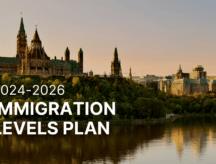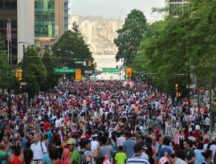25,000 Syrians in 100 days highlights the best of Canadian immigration
Yesterday marked the 5-year anniversary of the arrival of the first flight of Syrian refugees to Canada under Canada's 2015-16 Syrian refugee operation.
In November 2015, Canada began an ambitious effort to welcome 25,000 Syrian refugees within just a few months. The initiative was largely supported by the Canadian public, as it was an election issue the prior month when Canadians went to the polls in October 2015.
Justin Trudeau campaigned on a promise to welcome 25,000 Syrians by the end of the year. The shocking image of three-year old Syrian refugee Alan Kurdi's lifeless body washing to shore had a profound impact on the Canadian public. The main question wasn't whether Canada should go ahead with Operation Syria, but rather, if Trudeau's deadline would be achievable.
Find out if you’re eligible for Canadian immigration
Canadians gave Trudeau a majority government and as Prime Minister, he and his government pushed the deadline back to give the country enough time to prepare for, and execute the operation.
One hundred days later, on February 29, 2016, Canada had achieved its goal.
Achieving the goal was a massive undertaking.
Civil servants at Immigration, Refugees and Citizenship Canada (IRCC) worked around the clock. Many volunteered to leave their postings including the comfort of home during the holiday season to travel to the Middle East to support the operation.
Federal and provincial civil servants in Ottawa and across the country worked overtime throughout the holiday season, over weekends, and into the New Year.
The top federal and provincial immigration public servants engaged in daily conference calls.
When it was all said and done, many civil servants remarked that achieving this goal was the highlight of their careers.
While there were major doubts about Canada's ability to complete the Syrian initiative within such a short timeframe, there were no doubts about the generosity of Canadians.
Canada has a checkered history of helping refugees. For instance, it made the regrettable decision to remain on the sidelines during the Holocaust. However, Canada has sought to make amends since the end of the Second World War.
In a famous speech before Parliament on May 1st, 1947, Prime Minister William Lyon Mackenzie King articulated Canada's post-war immigration goals including that Canada had a moral obligation to assist refugees.
While King was no saint when it came to refugee assistance, as shown during the Holocaust, his speech helped to define the modern era of Canadian immigration. In the decades since the War, Canada has welcomed refugees from all corners of the globe.
The Syrian refugee effort has since gone down as one of the largest in Canadian history, ranking alongside the resettlement of Hungarian refugees in the 1950s and refugees from Vietnam, Laos, and Cambodia (the "boat people") in the 1970s.
The generosity of Canadians really came to light during the boat people operation as Canadians utilized the new "private sponsorship of refugees program" to help tens of thousands build a new life in Canada. The private sponsorship program, which was launched in 1978, enables Canadians to submit applications to the federal government to sponsor refugees from overseas and support them emotionally and financially upon arrival to Canada.
In large part to its boat people effort, Canada remains the first and only country to ever be awarded the Nansen Medal by the United Nations, which the people of Canada received in 1986. This is the highest distinction offered by the United Nations to recognize service to refugees.
Find out if you’re eligible for Canadian immigration
As was the case in the 1970s, strong demand among Canadians to help refugees overwhelmed the Canadian government during the Syrian refugee operation. The demand among Canadians to privately sponsor Syrians far exceeded the Canadian government's ability to process applications.
Canada's immigration minister at the time of Operation Syria, John McCallum, often joked in public he was the only immigration minister in the world that got criticized for not welcoming enough refugees.
In fact, the generosity of Canadians has since seen the country welcome some 45,000 Syrian refugees in total.
The 5-year anniversary of this initiative provides several helpful reminders.
First, Canada's federal and provincial governments can achieve their immigration goals if they prioritize them and devote enough resources. Often times both levels of government point to capacity constraints to explain shortcomings in the immigration system, such as slow processing times, and more recently, coronavirus-related challenges. However, capacity is determined by priorities and when an issue is prioritized, such as welcoming Syrians, or processing Express Entry applications within six months, Canada's governments are often able to achieve their immigration goals.
Second, while Canada has a reputation for operating a hard-nosed immigration system that purportedly poaches the best and brightest from other countries, there is a significant humanitarian bent to Canadian immigration policy. In fact, welcoming refugees comprises one of Canada's three major immigration goals (the other two goals are to strengthen the economy and reunite families). Canada is undoubtedly a global leader in refugee assistance.
Finally, welcoming newcomers makes Canada a more vibrant country. Not only does it support Canada's economic and social vibrancy, but it also brings out the best in Canadians. Average citizens, religious communities, corporations, non-profits, and governments all worked collectively to achieve the shared goal of welcoming 25,000 Syrians in 100 days. Before long, these former Syrian refugees will be on the frontlines helping future cohorts of newcomers land on their feet in Canada and make lasting contributions to Canada's economy and society.
Find out if you’re eligible for Canadian immigration
© 2020 CIC News All Rights Reserved
- Do you need Canadian immigration assistance? Contact the Contact Cohen Immigration Law firm by completing our form
- Send us your feedback or your non-legal assistance questions by emailing us at media@canadavisa.com







